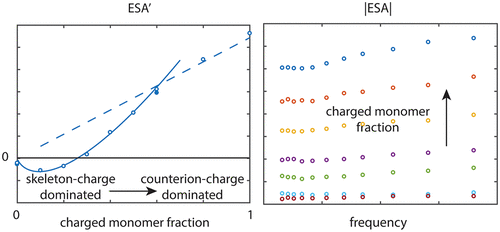当前位置:
X-MOL 学术
›
Macromolecules
›
论文详情
Our official English website, www.x-mol.net, welcomes your
feedback! (Note: you will need to create a separate account there.)
Electrokinetic Sonic Amplitude of Polyelectrolyte Solutions and Networks
Macromolecules ( IF 5.1 ) Pub Date : 2020-08-18 , DOI: 10.1021/acs.macromol.0c01409 Vahid Adibnia 1 , Gbolahan Afuwape 1 , Reghan J. Hill 1
Macromolecules ( IF 5.1 ) Pub Date : 2020-08-18 , DOI: 10.1021/acs.macromol.0c01409 Vahid Adibnia 1 , Gbolahan Afuwape 1 , Reghan J. Hill 1
Affiliation

|
As a first step toward understanding the electroacoustic response of polyelectrolyte hydrogel nanocomposites, we systematically vary the linear charge density of acrylic acid-co-acrylamide polymer networks (at a fixed total polymer concentration) to ascertain how the charge and mobility affect the electrokinetic sonic amplitude (ESA) spectra. A weakly charged polymer registers a negative ESA (real part), which we attribute to dynamics of the elastic network and its charge, whereas a highly charged polymer registers a positive ESA, attributed to sodium counterions. A mechanistic theoretical model is proposed that attributes the transition to the subtle manner in which the hydrodynamic friction of the network strands scale with their linear charge density. Further insights are gained from the electrical conductivity and dynamic shear moduli (in the linear viscoelastic regime). The electrical conductivity is dominated by the mobility of the sodium counterions and is diminished by network hindrance and counterion condensation, and the storage modulus decreases systematically with the linear charge density, suggesting a dominant role of interchain electrostatics, and possibly electro-steric influence on the polymerization and cross-linking.
中文翻译:

聚电解质溶液和网络的电动声幅
作为对理解的聚电解质水凝胶的纳米复合材料的电响应的第一步骤中,我们系统地改变丙烯酸-的线性电荷密度共-丙烯酰胺聚合物网络(在固定的总聚合物浓度下)以确定电荷和迁移率如何影响电动声幅(ESA)光谱。电荷较弱的聚合物记录的ESA为负(实数部分),这归因于弹性网络及其电荷的动力学,而电荷较高的聚合物记录的ESA为正,归因于钠抗衡离子。提出了一种力学理论模型,该模型将过渡归因于微妙的方式,在这种方式中,网状链的水动力摩擦随其线性电荷密度成比例增加。从电导率和动态剪切模量(在线性粘弹性范围内)可以获得更多的见解。
更新日期:2020-09-09
中文翻译:

聚电解质溶液和网络的电动声幅
作为对理解的聚电解质水凝胶的纳米复合材料的电响应的第一步骤中,我们系统地改变丙烯酸-的线性电荷密度共-丙烯酰胺聚合物网络(在固定的总聚合物浓度下)以确定电荷和迁移率如何影响电动声幅(ESA)光谱。电荷较弱的聚合物记录的ESA为负(实数部分),这归因于弹性网络及其电荷的动力学,而电荷较高的聚合物记录的ESA为正,归因于钠抗衡离子。提出了一种力学理论模型,该模型将过渡归因于微妙的方式,在这种方式中,网状链的水动力摩擦随其线性电荷密度成比例增加。从电导率和动态剪切模量(在线性粘弹性范围内)可以获得更多的见解。











































 京公网安备 11010802027423号
京公网安备 11010802027423号